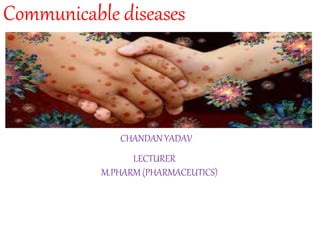
Communicable diseases
- 1. Communicable diseases CHANDAN YADAV LECTURER M.PHARM (PHARMACEUTICS)
- 2. Communicable Diseases Introduction- Communicable diseases are also know as Infection diseases. They spread from one person to another, a healthy person may catch it from an infected person. Communicable diseases spread through air , water , food, and direct contact. Communicable diseases are transmissible from one person or animal, to another.
- 3. Classification of Communicable Diseases The classification of communicable diseases depends on the causative agent and transmission mode: (i) Bacterial Diseases: typhoid , tuberculosis , cholera etc (ii) Viral Diseases: mumps , measles , polio , small pox , chicken pox , rabies etc. (iii) Fungal Diseases: ring worm , athlete’s foot etc. (iv) Rickettsial Diseases: typhus fever , trench fever , 2 – Based on the transmission mode, communicable diseases are of the following type: (i) Contagious diseases: In these diseases, the healthy person gets infected by physical contact with an infected person. Ex- chicken pox, small pox , leprosy etc.
- 4. • (ii) Non- Contagious diseases: In these diseases, healthy person gets infected on coming in contact with infected food, water or air . Ex- of non- contagious diseases are malaria, dengue etc. Transmission mode of communicable diseases • The transfer of diseases causing microbes ,such as bacteria and viruses take place between tow individuals by one or more of the following methods: • 1)Droplet contact: coughing or sneezing on other person. • 2) Direct physical contact: By touching an infected person. • 3)Indirect contact: By touching a contaminated surface.
- 5. 4) Air- borne Transmission: If the microorganisms persist in the air for longer period of time. 5) Faecal-oral transmission: From contaminated food or water sources. 6) Vector-borne transmission: By infected insects or other animals.
- 6. Measures for Prevention of communicable diseases 1)Diagnosis 2)Notification 3)Isolation 4)Treatment 5)Quarantine 6)Investigation 7)Disinfection 8) Blocking of transmission 9)Immunisation 10)Health Education
- 7. RESPIRATORY INFECTIONS INTRODUCTION: Infections of the sinuses, throat, airways, or lungs are categorised under respiratory tract infection (RTIs). These infection are mostly caused by viruses. And sometime by bacteria. Common cold is the most widespread respiratory tract infection. Infections of respiratory tract are categorised into two types. 1)Infections of upper respiratory tract: These infection affect the nose, sinuses, and throat. For example, 1)Common cold, 2)Influenza (deadly viral infection), 3)Whooping cough, 4)Tonsillitis (inflammation of the tonsils and tissues at the back of throat), 5)Sinusitis(inflammation of the sinuses),and 6)Laryngitis (inflammation of the larynx or voice box).
- 8. 2)Infection of lower respiratory tract: These infection affect the airways and lungs. For example Tuberculosis (bacterial infection of the lungs), Influenza, Bronchitis (inflammation of the lining of bronchial tubes),Pneumonia (inflammation of the air sacs as they fill with fluid),and Bronchitis(inflammation of the lining of bronchial tubes). Children are more prone to upper RTIs as their immunity(or resistance) power against many viruses is still not strong enough. 1. Chicken pox 2. Measles 3. Influenza 4. Whooping cough 5. Tuberculosis
- 9. INTESTINAL INFECTION Intestinal infection affect the gastrointestinal tract and mainly characterised by diarrhoea are categorised under intestinal Infection. The transmits through the contaminated food, water. Diarrhoea, abdominal pain, nausea and vomiting are the most common symptoms of an intestinal infection. These infection is caused by viruses, bacteria or other organism. Example – Bacteria infection Viral infection
- 10. Poliomyelitis - Poliomyelitis also called polio is an infection and acute disease affecting the CNS , which may lead to either temporary or permanent paralysis. The causative agent of poliomyelitis is polio virus, which is three types, I type , ll type, lll type. The disease affects the children below 5 years of age. Symptoms- fever, polio fever, sikness. Prevention- (i) person should be isolated. (ii) water source and supply of drinking water should be protected from contamination.
- 11. Cholera- Cholera is an acute intestinal infection. Within an hour of the onset of symptoms in a healthy individual, the blood pressure drop down to hypotensive levels, and the individual may die if not treated medically within three hours. Symptoms- symptoms appearing 1-3 days after infection range from mild, diarrhoea , Dry mouth and skin, Abdominal and leg cramps, low urine output, vomiting, tiredness etc. Prevention- water purification, sterilisation(clothing, bedding), traveller should be aware.
- 12. Typhoid- Typhoid, also know as typhoid fever is caused by ingesting the food or water contaminated with faeces from an infected person. Symptoms- Headaches, chest congestion, fever upto 104◦F, abdominal pain and discomfort, muscle aches and pains etc. Prevention- The important measures that should be considered to prevent typhoid infection are sanitation and hygiene. Careful food preparation and washing of hand is required for preventing typhoid infection.
- 13. Food poisoning- Symptoms- some characteristic symptoms of food poisoning are: 1. Nausea 2. Vomiting 3. Abdominal cramping 4. Diarrhoea Prevention- food poisoning can be prevented by safe handling, cooking and storage of food. Some preventive measures of food poisoning are given below: 1. Safe shopping 2. Safe storage of food 3. Safe food preparation 4. Safe cooking Hookworm infection-